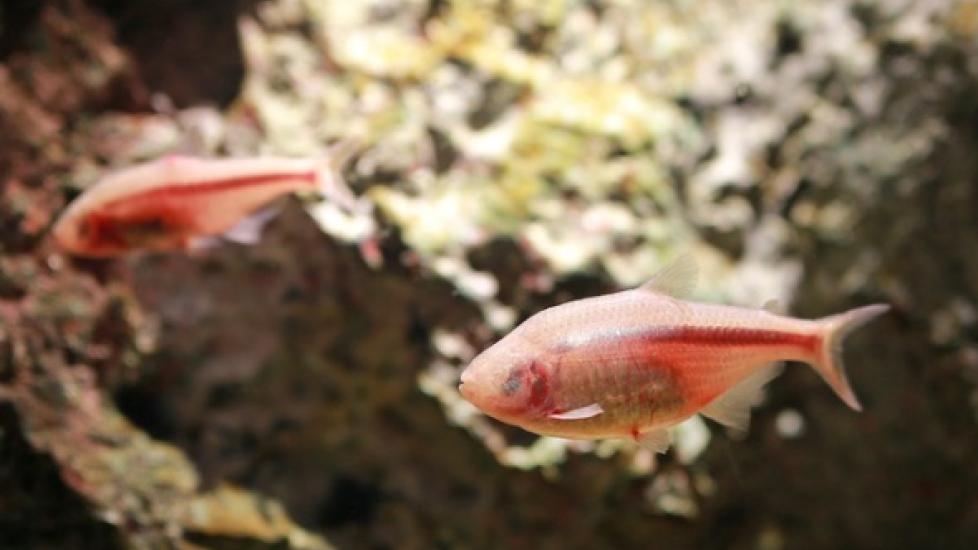A Look at the Blind Cave Tetra
Image via iStock.com/GOLFX
By Kenneth Wingerter
As many of us progress as fishkeepers, we are attracted to weirder and weirder species. A few of us may have even liked the oddballs from the get-go. However, one big impediment for beginners when it comes to keeping "unusual" aquarium species is the relatively specialized, advanced care that they typically require.
Luckily for novices and experts alike, there are a few incredibly weird fish species that are widely available in the aquarium trade and, most importantly, are relatively simple and straightforward to keep. One such species is the blind cave tetra fish (Astyanax mexicanus).
Living in the Dark
Also referred to as the Mexican tetra, this very unique species naturally occurs in variant forms: eyed and blind cave form (no eyes). For sure, the most popular Mexican tetra fish type amongst aquarists is the blind cave form.
While the eyes of newly hatched blind cave tetras are fully developed, they degenerate and are reabsorbed within a few weeks of life. When a fish is in “full” cave form, they are blind and also completely lack pigmentation.
Some researchers have proposed that the blind variant be recognized as a separate species. However, genetic evidence (as well as the fact that these variants can easily produce non-blind offspring when crossed) suggests otherwise. In fact, all of the populations across its natural range are very closely related.
Interestingly, the blindness trait appears to have arisen independently in at least a couple of instances during the species' evolutionary history. These cave-adapted (also known as troglomorphic) traits have become more prevalent in farmed specimens through selective breeding.
Some of the most pronounced adaptations of the cave-dwelling forms relate to feeding and nutrition. These include a more sensitive sense of taste and smell, as well as the ability to cope with inconsistent food availability. The blind cave tetra can reserve up to four times more energy in the form of fat and will accept nearly any kind of community aquarium fish food.
Home for a Cave Fish
You might think that it would be rather challenging to set up and operate a flooded cave biotope. For many cave-dwelling fish species, this is certainly so. The blind cave tetra, as peculiar as it is, clearly makes for an exception.
Believe it or not, your Mexican tetra fish tank technically can look and function like any conventional freshwater fish aquarium Blind cave tetras are appropriately sized for most tanks, generally growing to adult lengths of less than 4 inches. Up to a half-dozen may be kept in 20-gallon tank.
Aquarium Décor
Of course, one might wish to add some cave-like features to really help these fish feel at home. To start, the tank floor preferably will have a gravelly bottom cover such as Pure Water Pebbles aquarium substrate.
Rocks and other fish tank decorations might add welcome hiding places for individuals that get picked on or do not feel their best. Perfect for a tank with blind cave tetras are artificial, hollow "stones" that offer a cave-like look and act as great hideaways; examples include Marina polyresin cave aquarium décor or Underwater Galleries assorted aquarium caves.
Lighting
Since the animal is completely blind, it is inconsequential whether or not there is any light. While not necessary, blue illumination (as from an Aqueon flexible LED aquarium bubble wand) glows extra brightly over the blind cave tetra's pale body and produces dramatic effect for you to enjoy.
Tankmates
As a schooling species, the Astyanax mexicanus is rather peaceful. Still, as some individuals grow older, moderately aggressive tendencies might emerge. Blind cave tetras exhibit the most aggression toward other species at night (in the dark), which is when most of their tankmates are comparatively lethargic and clumsy. Even so, the tables are usually turned on the tetras, so their cohabitants must be entirely passive.
Cave Water
The blind cave tetra is happy in a wide range of aquarium conditions. Still, the keeper should, of course, maintain as healthy an environment as possible.
For Astyanax mexicanus, water temperature should be kept on the cooler side, at 68-77° F (20-25° C). The pH value may range anywhere from 6.0 to 7.5.
Though it is resilient, the blind cave tetra is, like other fishes, highly susceptible to the deleterious effects of ammonia and nitrite poisoning. As such, the keeper should first condition and stabilize the tank before stocking it with fish, and then take care to prevent polluting the aquarium water through overstocking and overfeeding.
While the tank will require some minimal water circulation for adequate aeration to take place, this species neither needs nor prefers very strong water movement.
A Unique, Low-Maintenance Choice
At some point, as you advance as an aquarist, you might wish to try a species that is decidedly out of the ordinary. Indeed, compared to any sort of exotic aquarium fish, the Mexican tetra is extraordinarily hardy and undemanding to keep. So, even if you do not necessarily possess the skill (or time) for high-maintenance species, the blind cave tetra is a fine choice.
With just a little bit of love and attention, this endlessly fascinating little fish can easily live to be 3 or 4 years old. With the occasional addition of new recruits and just a bit of care, a small school might be enjoyed indefinitely!
